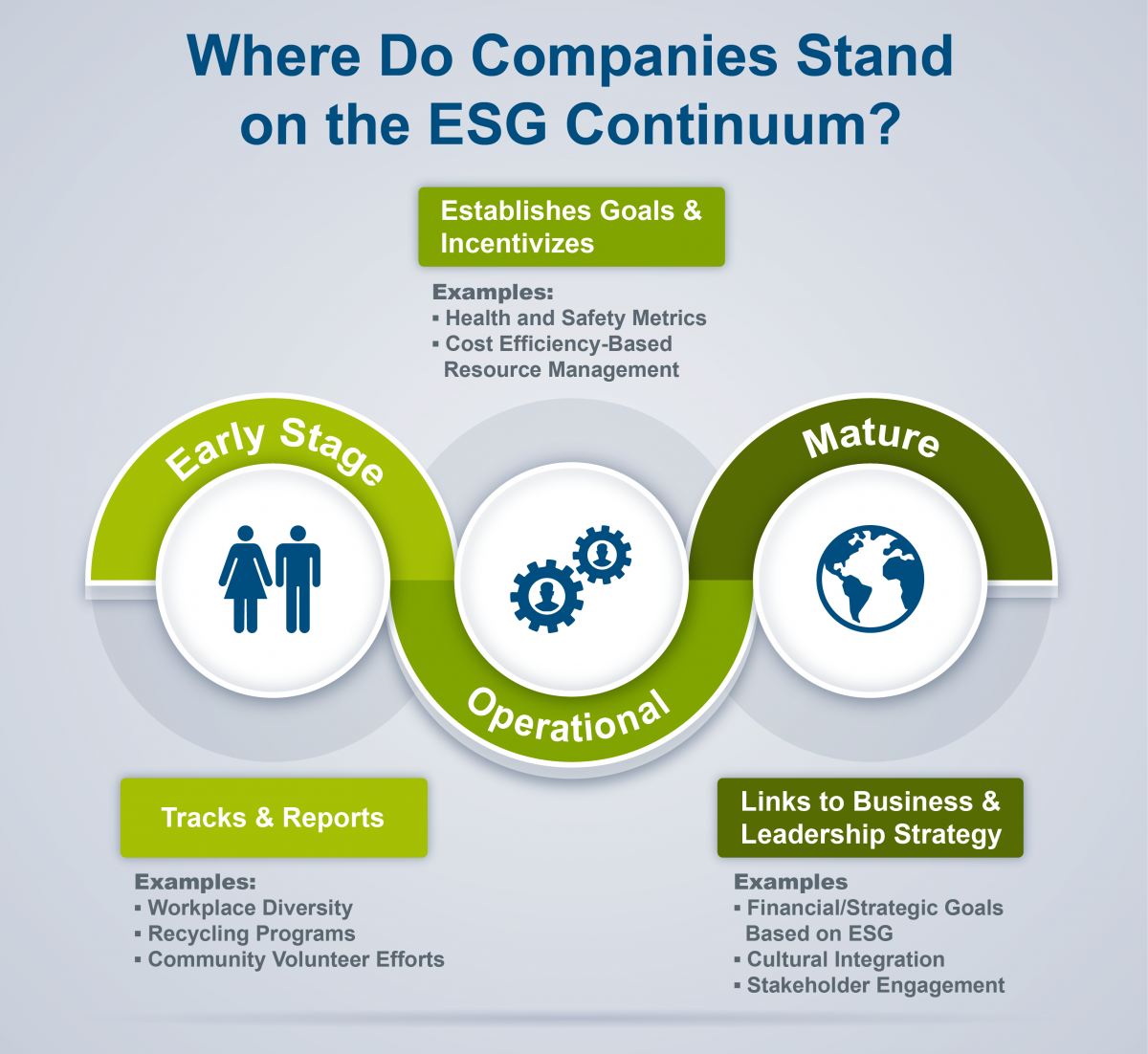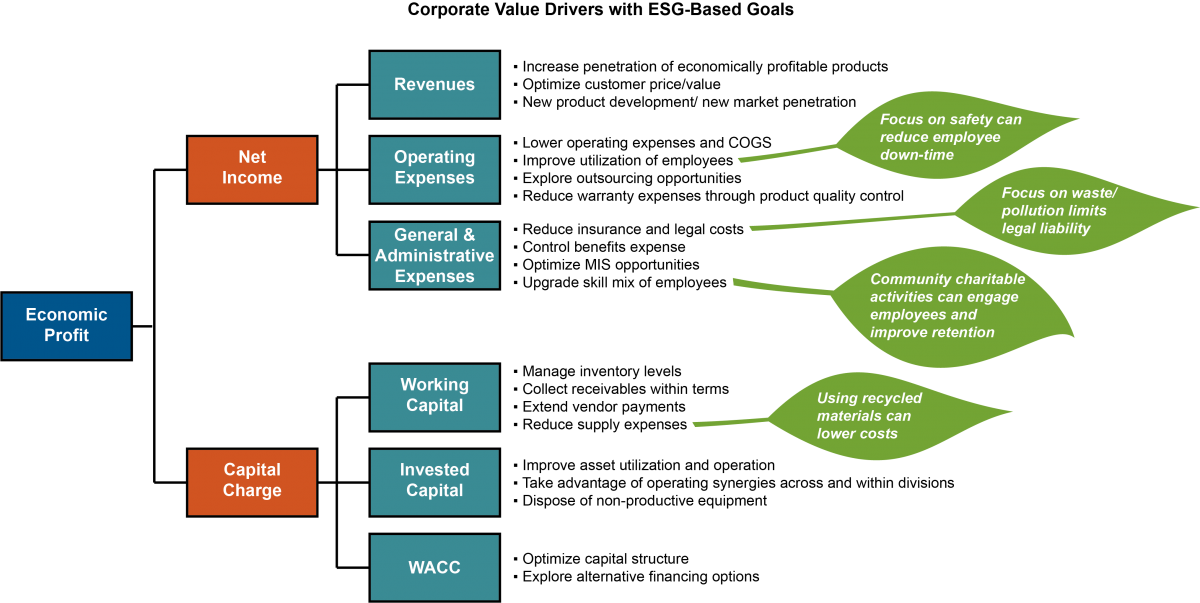
Article | Apr 2017 | NACD Governance Challenges
How Compensation Can Support Improved Environmental and Social Governance
For companies that want to strengthen their ESG focus and outcomes, incentive compensation programs can be a key to success.
Editor's Note: Pearl Meyer is a strategic content partner for the National Association of Corporate Directors (NACD). Pearl Meyer is a key contributor each year to the annual NACD Governance Challenges Report. The following article was published in the 2017 report "Board Oversight of ESG."
In the United States, environmental, social, and governance (ESG) issues have become a priority, especially for the largest public companies. In a 2017 survey, “Pearl Meyer Quick Poll: ESG and its Potential Link to Incentives,” 60 percent of companies surveyed report that ESG issues are a top concern and of those, 34 percent indicated that ESG issues are firmly entrenched in their companies. From an external reporting perspective, the Governance and Accountability Institute, a consulting and research firm focused on sustainability issues, says that in 2015, 81 percent of the S&P 500 published corporate reports on their ESG positions, up from just 20 percent four years prior. While not driven by disclosure regulation, the topic is receiving attention largely due to a combination of investor, employee, and customer interest.
Outside the United States, the interest in ESG is also being driven by regional regulation. For example, the Taiwan Stock Exchange requires that its listed companies publish a corporate social responsibility report and the Tokyo Stock Exchange’s governance code includes a strong suggestion that companies do so. Beginning in 2017, public companies in Europe with more than 500 employees will be required to report on several nonfinancial metrics related to the environment and their social and employment policies.
Recently, the Conference Board, Bloomberg, and the Global Reporting Initiative launched the Sustainability Practices Dashboard—a web-based tool with data on 75 social and environmental practices among the S&P Global 1200, including executive compensation policies tied to ESG metrics. It was developed in response to “growing demand from company directors, investors, financial analysts, and other stakeholders for comparative data in the sustainability field.”
Corporate boards appear to have taken note. The 2017 Pearl Meyer Quick Poll (also referred to as the “Pearl Meyer survey”) of more than 100 directors and corporate executives shows that 85 percent of respondents personally feel ESG issues should be formally addressed within a company. Almost 60 percent believe that ESG issues are important to customers and more than 75 percent say they are currently important to investors or may be in the future.
How are boards managing ESG?
At this point, most boards seem to be addressing ESG issues either through current standing committees or at the full board level. Research analysis done by Pearl Meyer in support of the NACD 2017 Director Compensation Report shows that among 1,400 public companies reviewed, only slightly more than five percent of boards have a designated committee to address ESG issues. Not surprisingly, most of the formal committees focus on environmental and safety issues, and the companies are in either the utilities, energy, or materials industries. The analysis shows that ESG issues are usually the responsibility of the governance committee and sometimes the audit committee.
What is the link between ESG and shareholder value?
With such strong board-level and investor focus on the topic, many have asked about the link between ESG and shareholder value. For example, a recent report from Glass Lewis notes that several global companies had “suffered massive blows to shareholder wealth as a result of significant environmental, social, and/or governance-related issues.” That same publication cites various research indicating companies that have adopted strong environmental and social policies may show better performance in financial metrics such as earnings per share, return on equity, and cash flow. And a 2012 study from Harvard Business School says these “high sustainability” companies “are more likely to make executive compensation a function of environmental, social, and external perception metrics."
Where do companies stand on the ESG continuum and what is the role of compensation?
We believe that most public companies are taking some sort of ESG action. Among those who are, they are likely somewhere on a continuum between simple reporting of basic ESG actions on one end, to an “ideal state” of seamless integration of numerous ESG issues into the corporate culture, business strategy, and executive-compensation plan. Where a company lands on this continuum may be driven in part by the size of the enterprise and/or its industry. For example, safety metrics have long been an element of many executive pay programs in the energy and manufacturing sectors.
Many companies are taking the customer, employee, and/or shareholder interest in ESG seriously and identifying those long-standing activities already taking place in their organizations that fall into the ESG category. Existing HR goals like hiring diversity or environmental, health, and safety measures can easily be reported as ESG-related actions. Energy usage and resource conservation efforts may also apply.
On some level, these types of identified actions may also be represented as a component of some executives’ performance-based compensation (particularly health and safety, as noted), but it is unlikely these factors are explicitly stated as ESG performance metrics. If present at all, the metrics are most likely indirect and folded into larger measurement components. Pearl Meyer’s survey showed 11 percent of respondents indicating direct links between executive compensation and ESG, with the most common factors being health and safety policies.
In an EY survey of executives at large-cap companies, 21 percent of these executives indicated “the leadership team’s compensation is driven in part by sustainability performance” and 30 percent said the company had received shareholder inquiries about the practice. Likewise, 24 percent of the large-cap firms studied by the nonprofit Ceres organization link executive pay to sustainability metrics.

At a minimum, one benefit of tracking these activities is that they can be packaged as a corporate social responsibility report, which can serve to either meet various regional requirements (e.g., those mentioned earlier for the Taiwan Stock Exchange, the European Union, etc.) or as a positive corporate communication to interested investors, employees, and customers.
Moving further along the scale, for some firms these more basic measures and additional factors, such as supply-chain processes or waste reduction, may be less on the margins and well incorporated into the functioning of the organization. This may be due in part to the company’s industry or business model and at some point the ESG elements become an ingrained part of how they do business or “operationalized." One director responding to the Pearl Meyer survey voiced the opinion that ESG is a part of the context in which the company operates, and to report on those factors solely as a result of investor or customer interest might not be a holistic view.
The same survey shows some level of ESG integration with business practice. Almost 30 percent of respondents have operationalized supply-chain practices (although only 11 percent of those have then made a direct link to compensation), and almost 40 percent have operationalized health and safety, 30 percent of which have then directly linked those measures to executive pay.
In the most mature phase, ESG-related practices are inherent to the firm’s business strategy and a core component of its culture. This maturity may have come about as a proactive hedge against disruption and may have required changes in product or service offerings, or possibly even business model or target markets. In these rare cases, the companies are very transparent about the role of ESG in their strategies and directly link ESG to the executive team’s pay.
The Ceres report noted previously calls out Alcoa as a shining example—where “20 percent of executive cash compensation is tied to safety, environmental stewardship (including GHG reductions and energy efficiency), and diversity goals”—and Exelon, a Fortune 100 energy company where the executive team is rewarded for “meeting non-financial performance goals, including safety targets, GHG emissions reduction targets, and goals engaging stakeholders to help shape the company’s public policy positions.”
These firms are certainly outliers, yet the Pearl Meyer survey shows that a remarkable number of executives and directors do believe ESG issues have a large role in their companies. Fifty percent say ESG issues are linked to the firm’s business strategy and 40 percent say they relate to business goals. Interestingly, one-third indicate ESG factors are “aligned with their firm’s value proposition and/or its competitive differentiation.”
A director responding to the Pearl Meyer survey did note that “some maturation needs to occur” in measuring ESG before there can be widespread adoption of ESG as an incentive metric.
Boards that are thinking about these issues now and taking steps to advance their progress are clearly ahead of the curve.
Linking ESG to financial results: compensation recommendations
In the long run, we believe executive compensation can be a powerful tool for advancing business and leadership strategies. For those boards that strongly believe in moving their companies along this continuum and pursuing a deeper operationalization of ESG factors—whether in response to regulation, stakeholder push, and/or the bottom line—incentives may be a catalyst.
- Each organization will approach ESG in the way that is best for its business model and culture. Companies can begin by evaluating a standard set of ESG components. Which of those are clearly linked to your business strategy?
- Conduct a value-driver analysis to understand which of those ESG factors have the most impact on the near-term business and which can drive long-term value creation.
- Balance the leading and lagging metrics that matter, using the same thoughtful methodology to determine the nonfinancial metrics linked to ESG as you do when choosing financial performance metrics.
- Design your pay programs to align with your value drivers and clearly outline to plan participants how they can get from point A to point B.
As is the case with financial results, setting ESG goals and measurements in this way will be an intensive exercise, requiring careful thought and analysis to be effective. One board member’s comment on the Pearl Meyer survey recognized both the difficulty and the reward by noting that managing ESG is a complex endeavor, yet managing complexity is a key to success.
Finally, beyond driving actions, don’t underestimate the role compensation can play in communicating priorities. Including incentives based on ESG in your plan signals to all stakeholders—including employees and management—its importance to the company and can spur the process of embedding it into the business and the culture.
